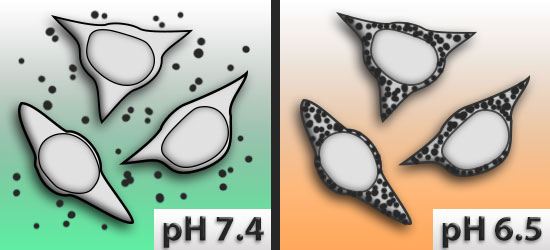|
September 30, 2013- Cancer researchers have a powerful new weapon in their arsenal: a small peptide that is triggered to fold and insert a payload of Nanogold® into a cell—but only in the acidic environment of a tumor. As Yao et al. discuss in the Proceedings of the National Academy of Sciences, loading tumor cells with gold nanoparticles offers important gains in both the diagnosis and treatment of cancer.
Delivering gold to tumors, while safely avoiding normal cells
pH Low Insertion Peptide (pHLIP) responds to the acidic environment that differentiates virtually all tumor cells from normal cells: it folds to form a transmembrane alpha-helix that then inserts into the cell membrane. If the peptide is bound to an appropriate payload, it will then transfer its cargo across the membrane and into the tumor.
Nanogold® reagents from Nanoprobes were particularly suited for delivery to the tumor. Because the gold nanoparticle is uncharged, it won't affect the key interaction of pHLIP with the acidic cancer environment. Equally important is the covalent mode of conjugation, which does not alter the properties of the pHLIP, and makes a very small and stable conjugate that readily crosses membranes.
Yao et al. conjugated pHLIP with Monomaleimido Nanogold®, which selectively reacted to attach the 1.4 nm Nanogold particle to a cysteine residue close to the peptide N-terminus. They then compared the uptake of the gold-pHLIP conjugate with that of unmodified gold particles in cultured HeLa-GFP cells. Uptake of gold-pHLIP nanoparticles was threefold higher than that of unmodified gold at pH 7.4, and 6.4-fold higher at pH 6.5, showing a pH dependent enhancement of uptake by the pHLIP.
Nanogold®-pHLIP was then tested in vivo by intratumoral and intravenous injection into mice implanted with subcutaneous . HeLa tumors. As controls, parallel experiments were performed using unconjugated Nanogold® particles, and Nanogold® conjugated to K-pHLIP, an engineered variant of pHLIP which does not react to acidic environments.
Inductively Coupled Plasma Mass Spectrometry measurements indicated that up to 54% i.d./g (injected gold dose/gram of tumor) was delivered by pHLIP and remained in the tumor after 24 h, compared to only 8% i.d./g in the case of non-functionalized gold nanoparticles. When pH-insensitive K-pHLIP was used as a delivery vehicle, tumor targeting was reduced threefold, demonstrating again that enhanced uptake was dependent upon the pH response of pHLIP.

In the acidic tumor environment, pHLIP folds to form a transmembrane alpha-helix,
inserting its payload of Nanogold® into the cell. Loading cancer cells with gold enables better tumor imaging and targeted cancer therapies.
Cancer theranostics with Nanogold®
Once the pHLIP peptide has transferred its payload across the cancer cell membrane, the Nanogold® particle can remain in the tumor for several days. During this time, the targeted gold can be used to facilitate both diagnosis and treatment of tumors.
First, gold-loaded tumors show selective contrast enhancement for better visualization and early detection using CT and other imaging methods. Next, radiation therapy can be enhanced, as the gold in tumors locally amplifies the radiation dose. Gold nanoparticles can also absorb infrared, so localized heating can be effected for tumor ablation or drug release at the tumor site.
"We're really honored that our nanoparticles are being used in the fight against cancer," said Dr. James F. Hainfeld, founder and chief scientist at Nanoprobes. "From our own cancer research, we know how much work goes into every one of these breakthroughs. We're excited to watch this project move forward."
pHLIP peptide targets nanogold particles to tumors.
Yao, L.; Daniels, J.; Moshnikova, A.; Kuznetsov, S.; Ahmed, A.; Engelman, D. M.; Reshetnyak, Y. K., and Andreev, O. A.: Proc. Natl. Acad. Sci. USA., 2013, 110, 465-470. doi: 10.1073/pnas.1219665110.
|